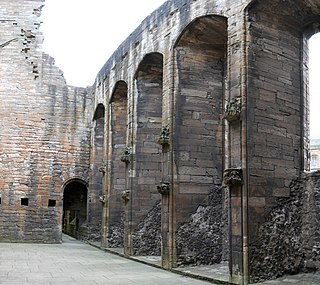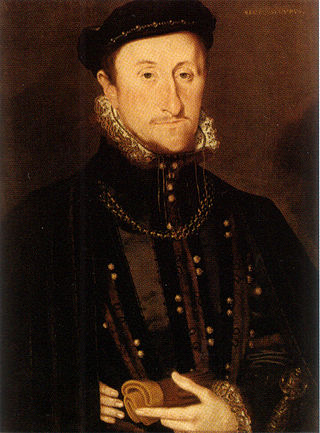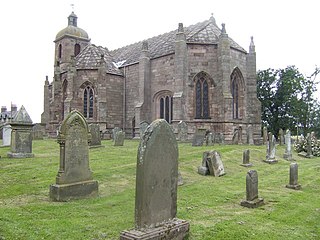Related Research Articles

Mary of Guise, also called Mary of Lorraine, was a French noblewoman of the House of Guise, a cadet branch of the House of Lorraine and one of the most powerful families in France. She was Queen of Scotland from 1538 until 1542, as the second wife of King James V. As the mother of Mary, Queen of Scots, she was a key figure in the political and religious upheaval that marked mid-16th-century Scotland, ruling the kingdom as regent on behalf of her daughter from 1554 until her death in 1560.

David Beaton was Archbishop of St Andrews and the last Scottish cardinal prior to the Reformation.

James Hamilton, 1st Duke of Châtellerault, 2nd Earl of Arran, was a Scottish nobleman and head of the House of Hamilton. A great-grandson of King James II of Scotland, he was heir presumptive to the Scottish throne. Arran was Regent of Scotland during the minority of Mary, Queen of Scots from 1543 to 1554, when he lost the regency to Mary of Guise. At first pro-English and Protestant, he converted to Catholicism in 1543 and supported a pro-French policy. He reluctantly agreed to Mary's marriage to Francis, eldest son of King Henry II of France, and was rewarded by Henry by being made Duke of Châtellerault in 1549. During the Scottish Reformation, Châtellerault joined the Protestant Lords of the Congregation to oppose the regency of Mary of Guise, and lost his French dukedom as a result.

James Hamilton, 3rd Earl of Arran (1537–1609) was a Scottish nobleman and soldier who opposed the French-dominated regency during the Scottish Reformation. He was the eldest son of James Hamilton, Duke of Châtellerault, sometime regent of Scotland. He was of royal descent, and at times was third or fourth in succession to the Scottish crown; several royal marriages were proposed for him, but he eventually never married. He went to France with Mary, Queen of Scots, where he commanded the Scots Guards. After returning to Scotland, he became a leader of the Protestant party against Mary and her French supporters. However, he went insane in 1562 and was confined for the rest of his life.

Dumbarton Castle has the longest recorded history of any stronghold in Scotland. It sits on a volcanic plug of basalt known as Dumbarton Rock which is 240 feet (73 m) high and overlooks the Scottish town of Dumbarton.

Sir James Hamilton of Finnart was a Scottish nobleman and architect, the illegitimate son of James Hamilton, 1st Earl of Arran, and Marion Boyd of Bonshaw. Although legitimated in 1512 while still a minor, he continued to be known as the "Bastard of Arran". As a key member of the Hamilton family, and second cousin of James V, King of Scotland, he became a prominent member of Scottish society.
James Kirkcaldy of Grange, a Fife laird and treasurer of Scotland.
Hugh Somerville, 5th Lord Somerville was a lord of the Parliament of Scotland. He is sometimes reckoned to be the 4th Lord Somerville. He succeeded his brother, John Somerville, 4th Lord Somerville. Hugh and John were sons of William Somerville, Master of Somerville, and Marjory Montgomerie.

The siege of St Andrews Castle (1546–1547) followed the killing of Cardinal David Beaton by a group of Protestants at St Andrews Castle. They remained in the castle and were besieged by the Governor of Scotland, Regent Arran. However, over 18 months the Scottish besieging forces made little impact, and the Castle finally surrendered to a French naval force after artillery bombardment. The Protestant garrison, including the preacher John Knox, were taken to France and used as galley slaves.
Alexander Crichton of Brunstane,, was a Scottish Protestant laird who advocated the murder of Cardinal David Beaton and supported the plan for the marriage of Mary, Queen of Scots and Prince Edward of England. In contemporary letters and documents Alexander is known by variant spellings of "Brunstane," his territorial designation. The original House of Brunstane was near Penicuik, and another Crichton estate at Gilberstoun near Portobello, Edinburgh later became known as Brunstane.
Robert Sempill, 3rd Lord Sempill was a Scottish lord of Parliament.
Sir William Hamilton of Sanquhar was pursemaster for James V and the Captain of Edinburgh Castle during the Regency of Regent Arran.
Robert Anstruther was a Scottish soldier in the service of Mary of Guise and Mary, Queen of Scots.
Walter Binning, or Bynning was a painter in 16th-century Edinburgh.

Thomas Arthur was a Scottish tailor who worked for James V of Scotland.

Robert Hamilton of Briggis was a Scottish soldier and military engineer. He was keeper of Linlithgow Palace and Dunbar Castle and was Master of the Scottish artillery.

William Danielstoun or Dennestoun was keeper of Linlithgow Palace for James V of Scotland.

James Barroun or Baron was a wealthy Scottish merchant based in Edinburgh and supporter of the Scottish Reformation.

Margaret Douglas, Countess of Arran and Duchess of Châtellerault was a Scottish aristocrat.

Thomas Peebles or Peblis was a Scottish glazier who worked for James IV, Margaret Tudor, and James V of Scotland.
References
- ↑ David Hay Fleming,Register of the Privy Seal, vol. 2 (Edinburgh, 1921), p. 23.
- ↑ David Hay Fleming, Register of the Privy Seal, 1542-1548, vol. 2 (Edinburgh, 1921), p. 35 no. 297.
- ↑ David Hay Fleming & James Beveridge, Register of the Privy Seal, 1542-1548, vol. 3 (Edinburgh, 1936), p. 6 no. 32.
- ↑ Marcus Merriman, Rough Wooings (Tuckwell, 2000), p. 336.
- ↑ James Balfour Paul, Accounts of the Treasurer, 1541-1546, vol. 8 (Edinburgh, 1908), p. lxxxii.
- ↑ David Laing, Works of John Knox, vol. 1 (Edinburgh, 1846), pp. 207, 329.
- ↑ James Balfour Paul, Accounts of the Treasurer, 1546-1551, vol. 9 (Edinburgh, 1911), pp. lxv, 134.
- ↑ James Balfour Paul, Accounts of the Treasurer, 1541-1546, vol. 8 (Edinburgh, 1908), pp. lii, lxxxvi.
- ↑ Joseph Bain, Calendar State Papers Scotland: 1547-1563, vol. 1 (Edinburgh, 1898), p. 5: Accounts of the Treasurer of Scotland, vol. 9 (Edinburgh, 1911), p. 56.
- ↑ HMC Manuscripts of David Milne Home of Wedderburn (London, 1902), pp. 207, 237.
- ↑ Maureen Meikle, 'Anna of Denmark's Coronation and Entry', Julian Goodare & Alasdair A. MacDonald, Sixteenth-Century Scotland (Brill, 2008), p. 284.
- ↑ Winifred Coutts, The Business of the College of Justice in 1600 (Edinburgh, 2003), p. 162.